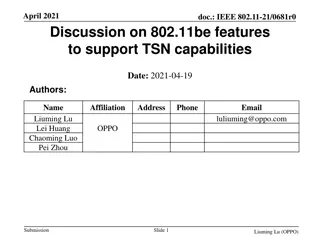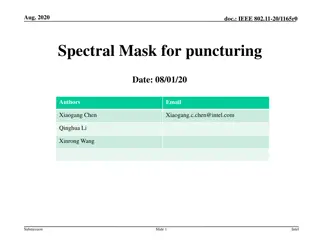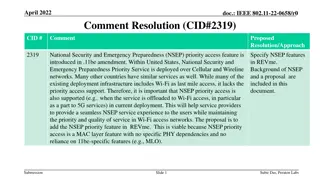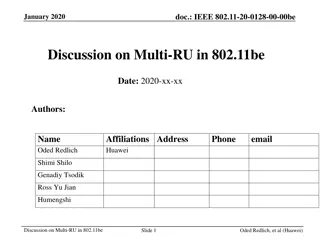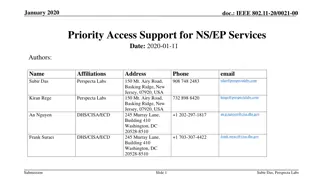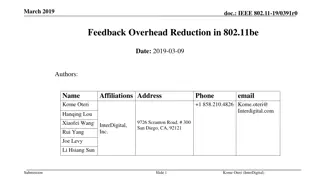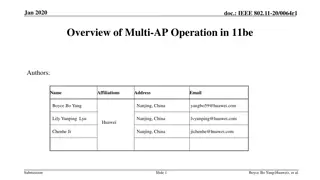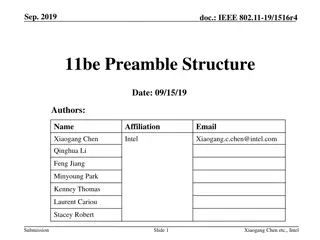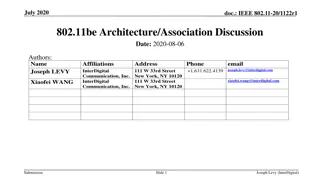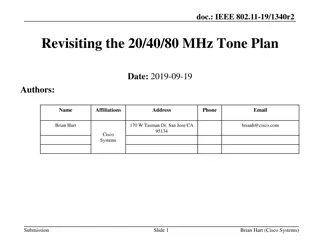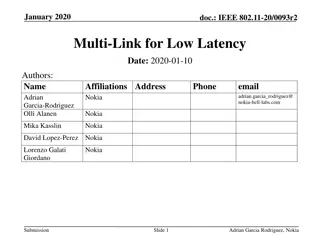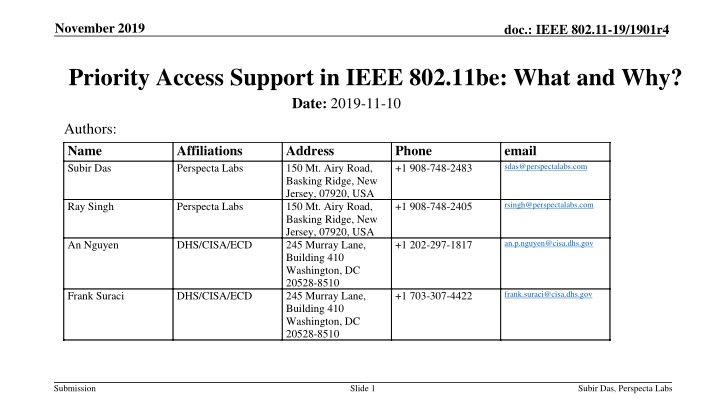
Priority Access Support in IEEE 802.11be for National Security and Emergency Preparedness
Explore the introduction of priority access support in IEEE 802.11be for National Security and Emergency Preparedness (NS/EP) services, addressing the increasing need for priority support over Wi-Fi access in critical situations. Learn about NS/EP priority services, their background, objectives, current gaps, and broader applicability in emergency telecommunications services.
Download Presentation

Please find below an Image/Link to download the presentation.
The content on the website is provided AS IS for your information and personal use only. It may not be sold, licensed, or shared on other websites without obtaining consent from the author. If you encounter any issues during the download, it is possible that the publisher has removed the file from their server.
You are allowed to download the files provided on this website for personal or commercial use, subject to the condition that they are used lawfully. All files are the property of their respective owners.
The content on the website is provided AS IS for your information and personal use only. It may not be sold, licensed, or shared on other websites without obtaining consent from the author.
E N D
Presentation Transcript
November 2019 doc.: IEEE 802.11-19/1901r4 Priority Access Support in IEEE 802.11be: What and Why? Date: 2019-11-10 Authors: Name Subir Das Affiliations Perspecta Labs Address 150 Mt. Airy Road, Basking Ridge, New Jersey, 07920, USA 150 Mt. Airy Road, Basking Ridge, New Jersey, 07920, USA 245 Murray Lane, Building 410 Washington, DC 20528-8510 245 Murray Lane, Building 410 Washington, DC 20528-8510 Phone +1 908-748-2483 email sdas@perspectalabs.com rsingh@perspectalabs.com Ray Singh Perspecta Labs +1 908-748-2405 an.p.nguyen@cisa.dhs.gov An Nguyen DHS/CISA/ECD +1 202-297-1817 frank.suraci@cisa.dhs.gov Frank Suraci DHS/CISA/ECD +1 703-307-4422 Submission Slide 1 Subir Das, Perspecta Labs
November 2019 doc.: IEEE 802.11-19/1901r4 Abstract This presentation introduces priority access support in IEEE 802.11be for National Security and Emergency Preparedness (NS/EP) priority services with additional applicability. Submission Slide 2 Subir Das, Perspecta Labs
November 2019 doc.: IEEE 802.11-19/1901r4 Outline NS/EP Priority Services Background Objectives Example Wi-Fi Use Cases and Assumptions Current Gaps Capabilities needed to support the NS/EP priority services Broader Applicability Straw Poll Submission Slide 3 Subir Das, Perspecta Labs
November 2019 doc.: IEEE 802.11-19/1901r4 Background Emergency Telecommunications Service (ETS) specified in [ITU-T E.107]: A national service, providing priority telecommunications to the ETS authorized users in times of disaster and emergencies (e.g., floods, earthquakes, hurricanes, terrorist attacks) In United States, DHS/ECD (Department of Homeland Security/Emergency Communications Division) priority telecommunications programs provide national security and emergency preparedness (NS/EP) and public safety users the ability to communicate on public telecommunications networks during times of congestion Government Emergency Telecommunications Service (GETS) Wireless Priority Service (WPS) Next Generation Network Priority Services (NGN PS) Telecommunications Service Priority (TSP) Submission Slide 4 Subir Das, Perspecta Labs
November 2019 doc.: IEEE 802.11-19/1901r4 NS/EP Priority Services in US GETS is operational since 1994 via a calling card service (voice only) Accessible from any domestic or international PSTN phone by dialing GETS access number, entering PIN, then Destination Number WPS is operational since 2002 via a subscribed phone over commercial wireless service (voice only) Accessible from a WPS subscribed phone of a participating carrier by dialing *272 + Destination Number - Offered by major cellular operators NGN Priority Services is developing new capabilities to support priority voice, data, video and information services on evolving networks Initial capabilities of GETS and WPS over IP are already deployed TSP authorizes organizations to receive priority restoration and expedited installation for important voice and data circuits NS/EP priority services are subscription based, operator controlled, enabled through global Standards, and are offered over commercial network infrastructure. Growing need for priority support over Wi-Fi access ! Submission Slide 5 Subir Das, Perspecta Labs
doc.: IEEE 802.11-19/1901r4 Objectives The primary goal is to be able to use Wi-Fi access networks in scenarios where Wi-Fi access may be the only available access networks such as inside a building, airports, stadiums or places where there is no cellular radio coverage available during NS/EP events A standardize mechanism to support the NS/EP priority services in WLAN (a.k.a. Wi-Fi access) networks without requiring additional infrastructure Submission Slide 6 Subir Das, Perspecta Labs
November 2019 doc.: IEEE 802.11-19/1901r4 Key Example NS/EP Use Cases for Wi-Fi General Emergency/Disaster Event NS/EP users use Wi-Fi access for priority communications during disaster event (e.g., coordination of response to terrorist attack from a hotel or enterprise Wi-Fi networks) Pandemic Event FCC CSRIC* (Communications, Security, Reliability and Interoperability Council) of USA predicted that pandemic event, may require up to 15 million mission-critical personnel forced to work in remote locations needing priority communications These users will be typically connected via home/residential Wi-Fi access networks In certain scenarios (e.g., inside the building), Wi-Fi may be the only available access networks NS/EP priority services communication from IoT devices IoT devices (e.g., industrial control monitor) with Wi-Fi connectivity for priority communications *Federal Communications Commission (FCC) CSRIC II report can be found at https://www.fcc.gov/about-fcc/advisory-committees/communications- security-reliability-and-interoperability-2 Submission Slide 7 Subir Das, Perspecta Labs
November 2019 doc.: IEEE 802.11-19/1901r4 A Specific NS/EP Priority Services Use Case: User s Perspective A terrorist event has occurred requiring coordination among field agents from federal, state, and local entities with an NS/EP role Coordination is managed from a nearby hotel conference room of a major hotel chain Cellular service in the conference room is very poor or not available Field agents and coordinators started using the hotel s Wi-Fi access network for their service Important Assumptions No separate APs or AP controllers are installed in the conference room and the hotel infrastructure is shared with other users Support of NS/EP priority services over operator/service provider controlled public Wi-Fi access networks Call/Session requests initiated are routed to NS/EP priority services provider s network for authentication and authorization as appropriate On demand support for originating and terminating communications Submission Slide 8 Subir Das, Perspecta Labs
November 2019 doc.: IEEE 802.11-19/1901r4 Wi-Fi Congestion: Call Fails Today LTE WiFi LTE WiFi WPS/NGN Priority Service Congestion in Wi-Fi network Public Network Congestion Congestion NS/EP Priority Service invoked The building Wi-Fi becomes congested and calls fail due to lack of NS/EP Priority over the Wi-Fi Submission Slide 9 Subir Das, Perspecta Labs
November 2019 doc.: IEEE 802.11-19/1901r4 What are the Gaps? There is no mechanism available today by which an NS/EP priority services user STA can be assigned priority for accessing a channel over other STAs during initial association As an example, 3GPP RAN defines special access class (4G) and access identity (5G) to allow high priority access during the initial attach on the air interface for NS/EP priority services users There is no means by which a NS/EP priority services user STA can be mapped to a priority QoS class over other STAs during data transmission after the channel access Submission Slide 10 Subir Das, Perspecta Labs
November 2019 doc.: IEEE 802.11-19/1901r4 What Capabilities are Needed to Enable NS/EP Priority Service? Priority Channel access for NS/EP user STA Admission control based on NS/EP Priority QoS treatment/mapping based on NS/EP Priority The goal is NOT to standardize an end-to-end service guarantee and anything related to higher layer services. The goal is to provide enough knobs at the PHY/MAC layers so that NS/EP priority services user STA can access the channel and data/message transmission obtains priority over other STAs in presence of Wi-Fi access network congestion. Submission Slide 11 Subir Das, Perspecta Labs
November 2019 doc.: IEEE 802.11-19/1901r4 Priority Channel Access Priority Channel access during initial association NS/EP priority services user STA should be identified and given priority over other STAs during initial association Priority Channel access during data transmission NS/EP priority services user STA should have Priority Channel access over other STAs when a data transmission is warranted for an NS/EP priority services session Note: In normal scenario (no priority service is invoked due to congestion), all NS/EP priority services user STAs should have equal opportunity to access the channel similar to other STAs. Submission Slide 12 Subir Das, Perspecta Labs
November 2019 doc.: IEEE 802.11-19/1901r4 Admission Control Priority Admission Control during initial association NS/EP priority services user STA should be admitted with higher priority over other STAs during initial association Priority Admission Control during data transmission NS/EP priority services user STA should be admitted with higher priority over other STAs when a data transmission is warranted for an NS/EP priority services session Submission Slide 13 Subir Das, Perspecta Labs
November 2019 doc.: IEEE 802.11-19/1901r4 QoS Treatment/Mapping QoS treatment/mapping during initial association NS/EP priority services STA should be mapped to a higher QoS access class over other STAs during initial association QoS treatment during data transmission NS/EP priority services STA should be mapped to a higher QoS class over other STAs when a data transmission is warranted for an NS/EP priority services session Submission Slide 14 Subir Das, Perspecta Labs
November 2019 doc.: IEEE 802.11-19/1901r4 Broader Applicability Priority Access in IEEE 802.11be would also be beneficial to other services, e.g., Mission Critical Services (e.g., MCx used for Public Safety) Emergency Services (e.g., 911 service in the US) Priority Commercial Application Services (e.g., critical medical applications) Submission Slide 15 Subir Das, Perspecta Labs
November 2019 doc.: IEEE 802.11-19/1901r4 References 1. FCC 47 CFR to Part 64 Priority Access Service (PAS) for National Security and Emergency Preparedness (NSEP): http://www.fcc.gov/ DHS/CISA/ECD: https://www.dhs.gov/cisa/emergency-communications-division-priority- telecommunications-services ATIS-0100009: Overview of Standards in Support of Emergency Telecommunication Service (ETS) and ATIS-01000010: Support of Emergency Telecommunications Service (ETS) in IP Networks https://www.fcc.gov/about-fcc/advisory-committees/communications-security-reliability-and- interoperability-2 3GPP TS 22.153: Technical Specification Group Services and System Aspects; Multimedia Priority Service (Release 8) 3GPP TR 22.854: Technical Specification Group Services and System Aspects; Feasibility Study on Multimedia Priority Service - Phase 2 (Release 17) 64 Appendix B, FCC Title 47 Telecommunication Appendix B to Part 64;Appendix B 2. 3. 4. 5. 6. Submission Slide 16 Subir Das, Perspecta Labs
doc.: IEEE 802.11-19/1901r4 Straw Poll Do you support adding to TGbe SFD that the 802.11be amendment shall define mechanism(s) in support of priority access to a non-AP STA for NS/EP Priority Service Note: Non-AP STA for NS/EP Priority Service is a regular non-AP STA that is associated to the AP and authorized to NS/EP service Result: Y: 45 N: 00 A: 31 Submission Slide 17 Subir Da, Perspecta Labs s
doc.: IEEE 802.11-19/1901r4 TGbe Motion Move to add the following to the TGbe SFD: The 802.11be amendment shall define mechanism(s) in support of priority access to a non-AP STA for NS/EP Priority Service. Note: Non-AP STA for NS/EP Priority Service is a regular non-AP STA that is associated to the AP and authorized to NS/EP Service. Moved By: Subir Das Submission Slide 18 Subir Da, Perspecta Labs
November 2019 doc.: IEEE 802.11-19/1901r4 THANK YOU Submission Slide 19 Subir Das, Perspecta Labs



